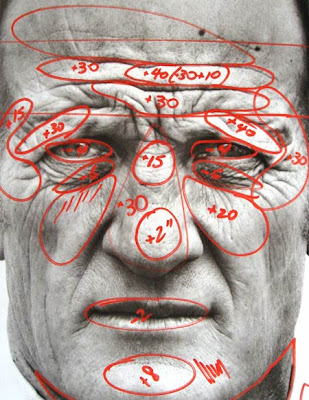before photoshop we had darkrooms
In photography communities online there's a persistent conceit about "getting it right in the camera" or "no photoshop". People often claim they like to "retain the original purity of photography".
Personally I think the argument is bollocks. Photoshop emulates the darkroom and if the darkroom could have done some of Photoshop's new tricks, you can be damn sure photographers would have used them.
As soon as we had photography, we had photographers who modified, tweaked, composited and just plain faked images. There was never any notion that it was a pure art form.
Consider this photo, showing Richard Avedon's notes to a printer about preparing a portrait shot for an exhibition:
That's the reality of photography. Photographers didn't shun post-processing just because it didn't happen in the camera. They always used every available technique and all available equipment to produce the best final result.
Photoshop did not really introduce anything to the equation, it just subtracted the chemicals and the annoying fumbling with film canisters in the pitch dark.
Composite images were always an ethical dilemma. The question of whether to alert the viewer that an image is not a raw capture has nothing to do with how it was created or processed.
So if you like to "do it all in camera" for the challenge, or the personal satisfaction; then good for you - it does take skill. Just as properly post-processing an image takes skill.
But if you claim you're doing it all in camera for reasons of being pure to some "original spirit" of photography... and especially if you think it gives some sort of moral or technical superiority over those who don't... well, with respect, I think you're demonstrating an ignorance of history rather than anything else.
[Image found via photographers: richard avedon's instructions for his printer. There's some more info at Camera Works: Photo Essay (washingtonpost.com).]

Post a Comment